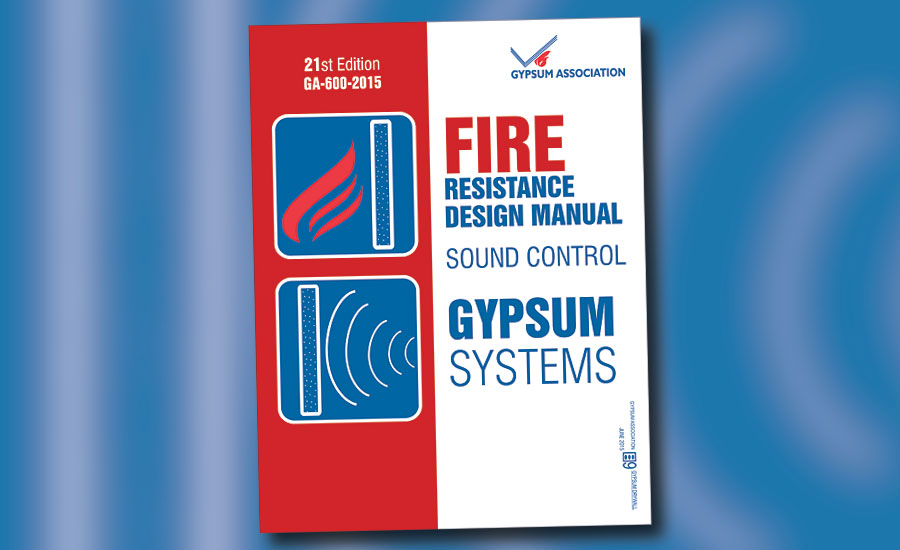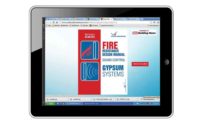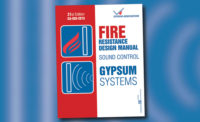As I write this, the 21st edition of the Gypsum Association’s Fire Resistance Design Manual (FRDM),GA-600-2015, is at the press. The GA-600 is revised on a three year basis, a cycle that coincides with the International Building Code and complete family of coordinated I-Codes. Although, a new manual is released every three years, the work is actually continuous. Already, new fire tests and associated designs are arriving at the GA offices for review and potential inclusion in GA-600-2018.
Still, seeing the new manual for the first time is always exciting both to GA staff and to the hardworking members of the Association’s Building Code and Technical Committee. Those member company technical representatives spend countless hours reviewing every detail of the manual and suggesting improvements. GA Senior Technical Director Robert Wessel, Ph.D., has served the committee as a member company volunteer and as the staff executive. This is the 11th FRDM he has contributed to and the 10th edition he has shepherded through the process. Is GA-600-2015 the best yet? “Every edition is the best one, yet!” he tells me. Given the additions and expansions incorporated during this revision, I would have to concur. GA-600-2015 is indeed the latest and greatest.
While everyone agrees that the new cover is smart looking and a nice departure from previous editions, it is the content that matters. Users of the manual run the gamut of design and construction personnel and include architects, engineers, and specifiers, as well as builders, general contractors, and drywall installers. The 2015 edition contains almost 100 new assemblies that supplement and expand existing systems for walls and partitions, floor-ceiling systems, area separation walls and many others. Among these are 20 new head-of-wall and base-of-wall systems that significantly expand the options for perimeter relief. Every system in the book is, of course, designed and evaluated to meet specific levels of fire resistance.
Bigger and Better
For Mary Meehan, the Gypsum Association’s technical services manager who already is kept busy answering GA technical hotline calls and emails, the addition of so many new systems at once is a bit intimidating. “A hundred new systems to memorize!” she cries out in mock-complaint. But she quickly goes on to praise the inclusion of those new perimeter relief systems. “There are so many different situations people encounter in the field. It will be really nice to be able to direct callers to a fire-rated system for perimeter relief that can be submitted to code officials with confidence.”
Speaking of fire tests, many of the test citations in the manual have been updated to reflect more current tests. And, for the first time, the General Explanatory Notes address how perfectly acceptable changes to a fire rated system—say, the addition of another layer of type X wallboard—may affect the Sound Transmission Class rating. Thus, an additional layer of type X, is permitted on any assembly built to the minimum requirements of a tested assembly, and that extra layer may, in fact, improve the STC.
What Mary and Bob and the rest of us here at the GA, are most excited about is the new and much more interactive digital version of the FRDM, that will be introduced with the 2015 edition. A PDF version of the FRDM has been available for quite some time, and judging by sales, is steadily growing in popularity. We have learned that PDFs are popular not only because they are available “on demand” from the GA Web site but also because people increasingly prefer storing and retrieving information electronically.
Like the hardcopy, the digital edition of GA-600-2015 is also the best yet—more like an e-reader than ever before. The table of contents is fully linked and will take readers directly to the sub-section of the book that they are most interested in, say for example, a 1-hour, wood framed chase wall. Given that the book is now 306 pages, the digital edition will be as easy to navigate as the hard copy, and will allow users to print the page that shows the assembly they want to consider, gain approval for, or build to. Plus, customers who order the digital edition of GA-600-2015 will receive a complimentary hardcopy.
Your Main Source
Since 1959, when what was then known as the “Technical Problems Committee” decide to produce a complete reference manual on fire resistance to be known as Fire Resistance Design Data Manual, the GA and its member companies have regularly engaged in testing and evaluation of both generic and proprietary systems. Within a few years of its first release, more than 20,000 copies of the Fire Resistance Data Design Manualhad been requested by architects and building officials. By the late 1960s, additional information on sound and structural assemblies expanded the manual even further. The value of GA-600 as a resource for the A/E/C community is reflected by the fact that for more than 40 years all the model building codes have referenced the FRDM as a source of fire resistive designs.
While the scope of GA-600 has steadily broadened to address sound and other factors of concern for designers, builders and the public, the commitment of the association and its member companies has never wavered. Always among the best organized and easiest to use of the design reference manuals, the FRDM has steadily improved with the addition of hundreds of assemblies over the years and now a more user friendly digital edition. With more than 700 systems addressing almost every imaginable condition, the GA-600-2015 is, indeed, the best yet.






